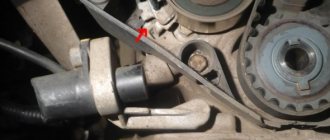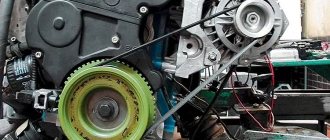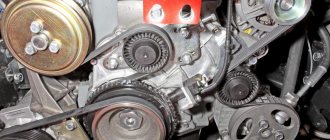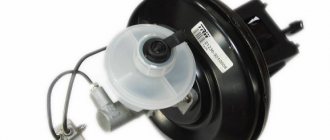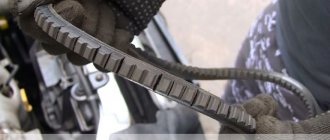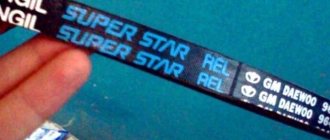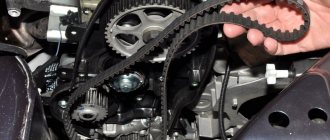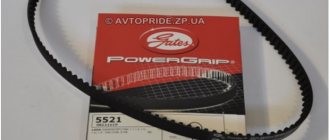The frequency of replacing the timing belt on a Chevrolet Cruze is 60,000 km or every 4 years (whichever happens faster). However, it is recommended to check the timing belt every 100,000 km.
When checking, you need to pay attention to the condition of the belt. Replacement is needed if its teeth are worn out, cuts, cracks, folds appear, or the fabric begins to peel off from the rubber. There should be no protruding threads or delaminations on the end faces, and the normal outer surface of the timing belt should not have any bulges or indentations.
In addition, traces of oil are unacceptable on it - it quickly destroys rubber materials; such a belt should be replaced immediately. As a rule, oil stains the belt due to leaky crankshaft and camshaft seals. Be that as it may, the cause of oil leakage must be eliminated.
When inspecting the timing belt, check its tension; at the proper level, the marks on the tensioner pulley and the bracket will match.
What engines were installed on the Chevrolet Cruze?
If this section is not important to you, move on to the next one.
If we talk about the USA, Europe, Japan, then to these countries, from 2008 to 2015, the car was supplied with gasoline and diesel engines: 1.3 liter M13A, 1.4 A14NET (A14XER LDD, diesel Z20DMH and Z20S1, 1.5 M15A), 1.6 (F16D3, F16D4), 1.7 (A17DTE, LUD), 1.8 (F18D4 ECOTEC, Z18XER), diesel 2.0 Z20D1 and Z20DMH.
As for Russia, the Chevrolet Cruze first appeared in our country in 2008, and it was produced from 2009 to 2015 in two cars in Kaliningrad and Shushary (St. Petersburg). At the first plant it was a station wagon, at the second - a sedan and a hatchback.
Sedans from 2009 to 2012 and hatchbacks from 2011 to 2012 were equipped with engines paired with manual and automatic transmissions:
- petrol cars 1.6 l. F16D3 with 109 hp (aka LXT) and 1.8 l. F18D4 at 141 hp (Opel engine).
- diesel Z18XER with 141 hp
Since 2012, a 1.4 turbo petrol engine LUJ with 140 hp has been added to the three engines above.
The restyled sedans from 2012 to 2015 were equipped with all the same engines as the hatchbacks, with the exception of the 1.4 liter LUJ turbo engine, which replaced the more modern 1.4 A14NET.
As for the SW station wagons, from 2012 to 2015 the following units were installed: a 1.6 liter petrol engine. F16D4 with 124 hp (a copy of the A16XER from Opel, also known as LDE) and the already known 1.8 liter with 141 hp. F18D4 (petrol), Z18XER (diesel).
All naturally aspirated engines listed above have a timing belt drive, except for the 1.4 liter turbocharged one, which has a chain drive.
From the above we can conclude that in Russia 1.6 liter engines are most widespread. 109 hp and 1.8 l. 141 hp
Using their example, the process of replacing the Chevrolet Cruze timing belt will be considered. Although the features of carrying out work on another engine (1.6 liters with 124 hp) will also be considered.
We would like to note right away that when the timing belt breaks, the valves bend on all the engines discussed below. This does not happen on all cylinders, but in any case it is impossible to do without a major overhaul of the cylinder head.
The following must be replaced: intake (with seat) and exhaust valves, guides, seals, hydraulic compensators, cylinder head gasket, camshaft seals, valve cover gasket, rollers, timing belt, etc.
Read more about the signs of a broken cylinder head lining.
F16D4 engine characteristics
Manufacture - GM DAT Engine brand F16D4 Years of production - (2008 - present) Cylinder block material - cast iron Power system - injector Type - in-line Number of cylinders - 4 Valves per cylinder - 4 Piston stroke - 81.5 mm Cylinder diameter - 79 mm Compression ratio - 10.8 (11) Engine displacement – 1598 cm3. Engine power – 115 (124) hp. /6000 rpm Torque - 155 Nm / 4000 rpm Fuel - 95 Environmental standards - Euro 5 Engine weight - n.d. Fuel consumption - city 8.9 l. | track 5.3 l. | mixed 6.6 l/100 km Oil consumption - up to 0.6 l/1000 km Engine oil for Chevrolet Cruze/Aveo: 5W-30 5W-40 0W-30 (Areas with temperatures below -25 C) 0W-40 (Areas with temperatures below - 25 C) How much oil is in the Lacetti engine: 4.5 liters. When replacing, pour about 4-4.5 liters. Oil changes are carried out once every 15,000 km In urban conditions, once every 7,500 km Engine life of the F16D4 Chevrolet Aveo/Cruz: 1. According to the plant - n.d. 2. In practice - 200-250 thousand km TUNING Potential - unknown Without loss of resource ~ 130 hp. Engine installed on: Chevrolet AveoChevrolet Cruze
Timing belt replacement periods for a Chevrolet Cruze
If we talk about the 1.8 F18D4 ECOTEC engine, then according to the regulations and repair manual, the timing belt on it must be replaced every 150,000 miles. The same applies to the 1.6 F16D4 (A16XER, LDE), Z16XER, Z18XER engines.
On the 1.6 F16D3 (LXT) engine, the timing belt is changed every 60,000 km.
If we talk about the chain drive (1.4-liter turbo engine), then it is designed for the entire life of the car, but it is recommended to check its condition every 120,000 km.
But if you rely on operating experience, then it is necessary to replace the belt much earlier.
The services recommend carrying out such work already at 90-100 thousand for F18D4 and 40-50 thousand for F16D3.
But in reality, the timing belt drive can break even earlier, for example, on the F18D4 engine this happened at both 60 and 70 thousand kilometers, proven by life experience.
Also, do not forget that some drivers (for example, taxi drivers) travel 60 thousand km. in two years, and others in 10 years. Naturally, after 8 years of operation, the timing belt has lost its quality and any load, for example, viscous oil in the engine, can lead to its breakage.
Therefore, if we are talking not about mileage, but about time indicators, then on the F16D3 engine, change the timing belt in any case after 5 years of operation, and on the F16D4, F18D4 - every 8 years.
Make it a rule for yourself to check the condition of the timing belt by external inspection every time you change the engine oil.
If the Chevrolet Cruze was purchased on the secondary market, then you can find out whether work was carried out to replace the product or not from the entries in the service book or contact the officials; their electronic database should contain notes about replacing the timing belt. Otherwise, you will have to remove the casing and determine its condition by eye.
There is such a thing as a “dry belt” - this is when it is not visually visible, but it is felt to the touch that the product has dried out over time and temperature, which means it will not take long before it breaks.
It is also important to pay attention to the presence of all teeth. Breaking one of them leads to a chain reaction, others begin to fall out, and this is not acceptable.
But in order to correctly determine how “live” the belt is, it will still have to be removed, and this is tantamount to replacement.
Maintenance
Operation of Chevrolet Aveo (F16D3), Chevrolet Cruze (F16D4 and F18D4) engines and other cars is carried out in accordance with the manufacturer's requirements for regular maintenance. Chevrolet Lacetti oil changes are carried out every 15 thousand km.
They include:
For engines installed on Chevrolet Cruze (F18D4), replacement:
- oil and fuel filters are produced no later than after 15,000 km. Used Chevrolet Cruze engine oil also requires replacement after 15 thousand km;
- spark plugs are performed after 60,000 km of travel;
- The drive belt and timing mechanism rollers are carried out no later than after 150 thousand kilometers. At the same time, after 100 thousand km, its condition must be checked and, at the slightest suspicion, changed. If the belt breaks during a trip, then expensive repairs cannot be avoided (the valve will bend);
- It is advisable to carry out the air filter after every 50,000 km traveled;
- The manufacturer recommends replacing coolant once every 5 years or no later than 240 thousand km of the distance traveled.
In engines of Chevrolet Aveo, Daewoo Lanos and others, replacement:
- engine oil is carried out every 15 thousand km of the distance traveled. It is also necessary to replace the oil, air and fuel filters;
- spark plugs must be checked after 45 thousand km;
- the belt and rollers of the gas distribution mechanism drive are performed every 60 thousand km to avoid valve failure;
- It is recommended to change the coolant once every two years.
In the Chevrolet Cruze engine (F18D4, etc.) during routine maintenance the following is changed:
- engine oil, gasoline and fuel filters - every 15 thousand km;
- spark plugs - after 60,000 km of travel;
- timing belt and rollers - after 100...150,000 km. If the belt breaks during movement, the valve bends;
- coolant - after 240,000 km or 5 years of operation (depending on which event comes first);
- air filter - no later than after 50,000 km.
Consumables for Chevrolet Lanos engines and engines of other cars manufactured by General Motors
The American concern General Motors, along with engines and cars, produces auto chemical products. The concern manufactures these products in strict accordance with the requirements for Chevrolet Cruze engines and their analogues.
That is why the technical documentation provides recommendations for using the original:
- GM Dexos 2 Long Life 5W-30 engine oil;
- GM Long Life Dex Cool antifreeze.
GM Dexos 2 Long Life 5W-30 engine oil is an original product, the chemical composition of which includes special additives that extend its service life and significantly increase the time interval between replacements.
The original antifreeze super concentrate GM Long Life Dex Cool has a unique chemical composition and has excellent anti-corrosion properties. The anti-corrosion substance, together with antifreeze, helps raise the boiling point and, in addition, prevents the coolant from freezing when exposed to low temperatures.
The antifreeze also contains emission inhibitors, which provide an extended service life (up to 250 thousand km or 5 years of operation).
Antifreeze of this class is intended for use in Chevrolet Aveo, Daewoo Nexia, etc. engines.
Adjusting the timing valve clearances
The engine of the Chevrolet Lacetti and other cars (F16D3) is equipped with hydraulic valve compensators, and therefore regular adjustment of the valve clearances is not required. The Chevrolet Cruze engine uses calibrated cups instead of hydraulic compensators, with the help of which valve clearances are adjusted. This procedure is carried out during maintenance at a service station after every 100,000 km.
What is recommended to be changed at the same time as replacing the belt?
During the work, not only the condition of the timing drive elements is checked at the same time.
Pay attention to:
- Condition of the accessory drive belt.
- Tension bypass rollers.
- Pumps (pulley play, leakage).
- The condition of the pulleys of the generator, power steering, air conditioner (if any) is backlash, misalignment, etc.).
- Camshaft oil seals (for more than 100,000 km). They are not visible behind the gears and the latter will have to be removed; for this, a 17mm socket is used.
- Condition of the crankshaft oil seal.
- Other elements.
Remember that jamming or misalignment of one of the rollers (jamming) can lead to a break in the timing drive, even if it is new.
By the way, you can immediately clean the throttle since it has full access.
As for the pump, it is changed during the second replacement of the timing belt for the F16D3 engine and during the first replacement for the F16D4, F18D4. Original number 96930074.
Analogs: Graf PA696, Hepu P795, Onnurri GWPD-003, SKF VKPC 90402, GMB GWG92A, Ruville 69004, Daewoo 96352650, INA 538 0066 10. Conflicting reviews about the Dolz D-211 model.
If the pump is “live”, but there are smudges from under the gasket, then the latter must be changed - original number 94580509.
All consumables are purchased separately or as part of special timing kits. The second option is preferable for a planned replacement, and the first, if some product (part) fails ahead of time.
Choosing a timing belt for the Chevrolet Cruze
Before starting work, it is important to select high-quality components and protect yourself from counterfeiting.
If the replacement takes place at a car service, then the selection of components can be carried out according to the VIN code of the car. True, they write on the forums that the Ukrainian VIN does not make its way into Russia, but for us this is most likely the exception rather than the rule.
Catalog numbers for each motor model are different.
For 1.6 F16D3 at 109 hp. Original products manufactured by GM Korea/Daewoo with catalog numbers are suitable:
- Timing belt – 96417177 (127 teeth).
- Tension roller – 96350550.
- Support roller (guide) – 96350526.
As for the original product 96417177, you can find a lot of negative reviews about it on the forums, and not without reason.
The fact is that in 2012, defective products entered the market and timing belt breaks occurred on many cars. This problem has now been resolved.
Analogues:
- Timing belt: BOSCH 1 987 949 403, GATES 5419XS, Contitech CE887, SKF VKMA 05260, DAYCO 941025, CONTITECH CT887, Ina 536 0290 10, MITSUBISHI 127XR25, INA 536 0110 10 (G Germany).
- Timing tensioner pulley - INA 531021330,
- Accessory drive belt tensioner roller INA 532019420.
Non-original timing kits for the Chevrolet Cruze can be supplied with or without a pump:
- K015419XS (without pump) with tension and support rollers. Analogues - CONTITECH CT887K1, GM 93744703, RUVILLE 5900270, Thor T11002, BOSCH 1987948226, DAYCO KTB559, NTN-SNR KD45313, SKF VKMA90000.
- Set Ina 530 0332 09 which includes two rollers: parasitic roller Ina 532 0194 20 (original GMB GT80750) and tension roller Ina 531 0213 30. Or set Ina 530 0332 10.
- KP15419XS2 with pump + two rollers included. Analogues: BOSCH 1987946478 and CONTITECH CT887WP2.
Original components for Chevrolet Cruze 1.6 F16D4 (1.8 F18D4) and 1.8 2H0/Z18XER engines:
- Timing belt GM 24422964 (146 teeth).
- Tensioner roller GM 55574864.
- Guide roller (parasitic) GM/Daewoo 24436052.
- Original GM pump 24405895.
Timing belt analogs for the above engines: GATES 5603XS, SKF VKMT05260, JAPKO 40W10, OPEL 5636436, BOSCH 1987949590 and others.
The following may also require replacement:
- Drive belt tensioner roller GATES t
- Power steering belt GATES 4PK643SF.
Since Gates products are popular, counterfeits began to appear on the market, and in order to protect itself from low-quality components, the company created a service to check its spare parts for originality.
Kits:
- K015603XS (without pump) – belt, two rollers (installed at the factory), three bolts including the crankshaft. XS means reinforced belt.
- Ina 530 0450 09 – the kit includes guide 532 0472 10 and tension rollers 531 0779 10 with bolts.
Additionally, on the 1.8 F18D4/Z18XER engine with air conditioning, the following are checked and, if necessary, replaced: power steering and alternator belts with pump (GATES 4PK643SF and 6PK1555, respectively), tensioner pulley GTA0240 GMB.
When replacing the timing belt, a pump must be purchased along with the main components and installed if necessary. If there is no such need, then it is sent for storage until next time. In rare cases, camshaft seals may also be needed.
Resource of 1.4-liter engines
Considering the car from the point of view of the reliability of the 1.4-liter engines, you need to familiarize yourself in detail with the endurance of the two power units presented as the main ones for the car intended for the Russian market. Next, let's look at the service life of the Chevrolet Cruze 1.4 engine - these are turbocharged LUJ and A4NET.
L.U.J.
In 2012, the Chevrolet Cruze received a LUJ turbocharged gasoline engine. In fact, the unit is an exact copy of the A14NET, which is well known to ordinary car enthusiasts from the Opel model range. Despite the general design identity, each of the motors has some distinctive features. For example, LUJ received a direct fuel injection system, when the A14NET distributed injection of the fuel mixture into the engine cylinders. Due to the low-pressure turbine (approximately 0.5 bar), both units produce the same number of horsepower - 140. As for its overall design, the LUJ consists of an aluminum cylinder block with a 16-valve head made of lightweight materials. The maximum torque of 200 Nm is generated when the engine reaches 4900 rpm. The chain acts as a drive for the gas distribution mechanism. It increases the reliability of the engine, hence the service life, but it is not enough for the entire life of the car.
Reviews from car owners indicate that LUJ does not have serious engineering flaws, but has received a small number of chronic “illnesses”. This number includes the problematic crankcase ventilation system. Due to the design tricks that General Motors engineers had to resort to, the diaphragm, check valve and corrugated hose in a turbocharged engine suffer and fail prematurely. The first symptoms of a breakdown of one of the components of the crankcase ventilation system can be recognized by increased engine oil consumption, a hissing sound in the engine compartment, floating speed and increased fuel level. In no case should the problems associated with VCG be ignored, because due to the increasing pressure under the influence of the air inflated by the turbine, serious engine damage is possible. If you correct the slightest faults in time and monitor the condition of the car, the LUJ engine will be able to operate from 300,000 to 350,000 kilometers.
A14NET
In its design, the turbocharged 1.4-liter A14NET is completely identical to the LUJ. Still the same aluminum cylinder block and 16-valve head. A 0.5 bar turbine, which allows the engine to produce 140 horsepower with a small working volume of the unit - 1.4 liters. It seems that such an engine is perfection itself. It is economical, high-torque, provides the necessary dynamism to the car and has a good service life. But in practice, things are a little different. The engine is demanding on the quality of engine oil, so you need to pour only the official lubricant recommended by the manufacturer. To develop all the potential inherent in the engine, you will have to drive carefully and measuredly. An aggressive driving style has a very detrimental effect on the general condition of the engine, the turbine in particular.
The main problem of A14NET, which causes not the most pleasant emotions among car owners, is the valve cover gasket, which can leak at any time
It doesn’t matter whether the car is new or old, you need to be prepared for the fact that engine oil will start oozing from under the cap. The engine also likes to vibrate a little, in principle, there is nothing terrible about this, since slight vibrations at low speeds are one of the features of turbocharged engines produced by General Motors
If we sum up all of the above, we get a pretty good modern engine. It received a number of technological systems designed to ensure uninterrupted operation of the engine throughout the entire period of operation. It is poorly suited for racing, but quite suitable for everyday quiet city use. If you monitor its condition and correct the slightest faults in a timely manner, it will last 300 thousand kilometers. Additional information about this unit can be found in the article Opel Zafira engine resource.
The procedure for replacing the timing belt on a 1.6 109 hp engine. F16D3 with pump replacement
If you have any doubts about the correctness of further actions, first read the instructions from the operating manual, which are presented below.
1 of 4
— +
1.
2.
3.
4.
But since everything is written there in a simplified version, this will cause difficulty for many. We will describe the replacement of the timing belt in detail and step by step.
First of all, prepare a jack, a set of wrenches (mostly you will need 10, 15, 17 sockets), a Torx set, a wrench with an extension, a screwdriver, a container for draining the coolant (when replacing the pump), rags, a torque wrench (preferably).
Work order.
Remove the air filter with housing. To do this, disconnect the air duct from the throttle assembly, the crankcase gas pipe, and disconnect the connector of the mass air flow sensor.
Close the throttle valve to prevent dirt from getting in.
We jack up the engine on the right in the direction of travel through a wooden support so as not to bend the pan. If there is engine protection, it will have to be removed.
Using a 15mm socket, unscrew the three engine mount mounting bolts and one nut and two bolts securing the right mount bracket.
Unfasten and move aside the power steering hose.
Remove the upper plastic timing belt protection. It is fastened with clamps and three bolts, which are unscrewed with a 10mm head.
We jack up the car, remove the wheel and three clips securing the fender liner (locker), and also unscrew the two self-tapping screws on the right. We open access to the pulley.
Using a 17mm socket, unscrew the crankshaft pulley. In services this is done using a pneumatic gun. In garage conditions, to remove the bolt, ask an assistant to engage 4th or 5th gear and squeeze the brake. If you don't have an assistant, insert a flat pry bar from the back of the pulley and rest it against the air conditioner.
It is recommended to replace the old bolt with a new one. Carefully inspect the keyway of the pulley; if there is the slightest damage, it should be replaced.
Remove the lower plastic timing belt protection. It is secured with three 10mm bolts and latches.
Using a 10mm socket, remove the engine mount mounting bracket, which is attached in four places.
Using a 15mm wrench, move the drive belt tension roller clockwise and remove the latter. Access is possible both from below and from above.
Check the condition of the drive belt and replace if necessary.
Align the mark on the crankshaft with the slot on the casing. The marks on the camshafts should also match.
We tear off the bolts securing the camshaft gears with a 17mm head.
Use a Torx head to loosen the three pump mounting bolts. We move the latter and remove the timing belt.
If the pump does not change, then press the tension roller lock with a screwdriver and loosen the belt.
But the first option is considered correct, it is also stated in the repair manual. It is not recommended to touch the tension roller.
We unscrew the pulley bolts and remove the latter. It is impossible to confuse them.
Using a 12mm socket, unscrew the three bolts securing the tension roller.
Use a 15mm socket to unscrew the deflection roller.
Remove the inner side of the belt protection housing, which is attached to the motor. To do this, unscrew the two bottom bolts with a 12mm socket, the two bolts on the sides with a 10mm socket and the two camshaft sensor bolts.
Drain the antifreeze (when replacing the pump).
Unscrew the three bolts with a Torx head and remove the pump.
Clean the pump installation area from dirt.
We install a new pump, attach it to the bolts without tightening the latter, since the pump will tension the belt.
Then we proceed in reverse order:
- We attach the rear part of the casing to the engine.
- Install the camshaft sensor.
- We install the bypass and tension rollers. The bolts are tightened with a force of 28 Nm.
- Install the camshaft pulleys (do not tighten the bolts yet).
Starting a new belt:
- If there are no arrows and the question arises which side to put on, then you need to position the belt so that the markings on it are readable.
- We start from the bottom, on the right side counterclockwise: the crankshaft gear, the idler pulley, the right and left pulleys, we start on the pump and the tension roller.
- We tighten the belt with the pump by rotating it clockwise. There are two indicators on the tension roller, movable and non-movable. When turning the pump, the movable pointer will move counterclockwise towards the stationary one. When they coincide, the belt tension force is considered normal.
- Tighten the pump bolts to 10 Nm.
- Tighten the camshaft bolts with a force of 67.5 Nm.
- Rotating the crankshaft bolt with a cry, turn the latter 720 degrees (2 times) and check the position of the marks, make sure that they coincide.
Next we install:
- Engine mount mounting bracket.
- Lower belt protection.
- Crankshaft pulley. Tighten with a force of 95 Nm. Then we turn it 45 degrees and another 15 degrees.
- Drive belt.
- Engine support cushion and jack up the latter.
- We fasten the fender liners in place.
- We put the wheel on and remove the car from the jack.
- Then we install everything in its regular place.
- Fill in antifreeze (if it has been drained).
We start the car and check the correctness of the sawed work.
Replacing the timing belt on the F18D4 1.8 141 hp engine.
The tool set is the same as for the 1.6 109 hp engine.
We also dismantle the air filter; it is not screwed on and sits on rubber bushings.
Close the throttle valve.
Jack up the engine and unscrew the mount with a 15mm head.
To remove the drive belts, you need to loosen the power steering pump pulley. The top bolt is completely unscrewed, and the bottom bolt is loosened.
To do this, jack up the car and remove the right front wheel and remove the three clips and bend the locker.
Use the E18 head to turn the crankshaft until the hole in the pulley fits into the upper bolt.
Using a 13mm socket, unscrew the top bolt.
We adjust the hole for the lower bolt and loosen the last one. You need a short 13mm head with a cardan.
Move the power steering to the left and remove the drive belt (original number 4PK643).
Using a 15mm socket, unscrew the three bolts of the engine mount mounting bracket. If necessary, the engine is jacked up even more.
Using a 19 socket, loosen the tension roller by turning it counterclockwise and remove the accessory drive belt (original number 6PK1557, 6PK1555, which is 2 mm shorter, is also suitable).
We check the condition of the pump, generator, and air conditioner for sound.
Using an E10 head, unscrew the two bolts and remove the top cover.
Unsnap the second cover. It is attached with a hook (on the left side), an eyelet on the right.
Using the E14 head from below, loosen the bolt of the drive belt tensioning mechanism and remove the latter (if the task is to replace it).
Using the E18 head, unscrew the crankshaft bolt. To do this, ask an assistant to engage 4th or 5th gear and depress the brake pedal. We remove the pulley.
Find the crankshaft marks.
Unscrew the 4 bolts (two on the bottom, two on the top) of the boot and remove the last one.
We check the condition of the crankshaft oil seal and other timing drive components.
We set the camshaft marks. On the right there is a point, on the left there is low tide. They must match.
The marks on the crankshaft must also match.
Secure the timing pulleys. To do this, you can use factory solutions for the Chevrolet Cruze or use a bolt as shown below.
You can make such a clamp yourself from a 3 cm corner.
Using a Torx t50 bit, unscrew the tension roller and remove the timing belt.
Use the same head to unscrew the deflection roller.
We remove the belt.
We install new bypass and tension rollers. The latter has a special ebb-retainer, which is inserted into a special socket.
It's difficult to confuse.
We tighten it. Bypass with a force of 25 Nm, tension - 20 Nm.
Install the belt. First, onto the crankshaft gear, idler roller and onto the right and left camshafts.
Insert a 5mm hex into the tension roller and loosen it by turning it clockwise using the wrench. Throw a belt over the roller.
Unlock the camshafts by removing the bolt.
Make sure the marks match everywhere.
Install the bottom plastic protective cover. Bolt tightening torque 6 Nm.
We install the crankshaft pulley along the key and tighten the bolt (if it is included in the kit, then install a new one). For now we are just making money.
We change (if necessary) the drive belt tension roller (number t39291), but before that you need to remove the old one.
To do this, unscrew the bolt with a 13mm head. ATTENTION – THREAD IS LEFT.
Tighten the bolt with a force of 50 Nm.
We install the drive belt in its original place.
To loosen the tensioner, use a 19mm socket. Move the key towards the windshield.
We install the lower protective cover and the pillow bracket.
We install the power steering drive belt; as an example, GATES 4PK643 is suitable.
We attach and tighten the top bolt.
Rotate the crankshaft to align the hole in the pulley with the lower bolt and tighten the latter.
ATTENTION. You only need to turn it clockwise, in this case the gas distribution elements will not be heavily loaded.
Install:
- top cover;
- fastening the right support bracket;
- air filter.
1 of 3
— +
1.
2.
3.
We tighten the crankshaft bolt, but first the latter must be locked. In the usual way (an assistant presses the brake in fifth gear), but this method is suitable if you have a car with a manual transmission, and if you have an automatic transmission, then you can do this by blocking the flywheel.
Under the engine we find a bar behind which the flywheel is hidden. Using heads 15 and 18, unscrew the two bolts and remove the bar. Use a powerful screwdriver or other method to lock the flywheel.
We set the torque wrench to 95 Nm and do the first pull.
Next, take a regular knob and turn it 30, and then another degree.
We install the locker in place and return the metal bar behind which the flywheel is located.
Part one - dismantling.
Part 2 – installation.
Overhaul of a Chevrolet car engine
Overhaul of the engine of this model, like other car brands, is a rather complex and labor-intensive process, during which the most complete analysis of the engine is carried out, and most of its parts are replaced. This type of repair is recommended in the following cases:
- there is an increased consumption of fuel and oil;
- the motor is unstable;
- extraneous sounds in the engine have become more frequent;
- the power dropped significantly.
Where to turn in such situations? It is not recommended to try to repair a Chevrolet engine with your own hands, without professional knowledge and skills, as this is fraught with deterioration in the technical characteristics of the car. It's better to seek professional help.
Our service center specialists will help you repair your Chevrolet engine on a turnkey basis cheaply, efficiently and in the shortest possible time. You just need to bring the vehicle to our service center, wait for the repair work to be completed, after which you can again enjoy driving your own car.
| Chevrolet Cruze engine diagnostics | Chevrolet Cruze crankshaft grinding | Chevrolet Cruze valve adjustment |
| Chevrolet Cruze engine overhaul | Chevrolet Cruze cylinder block boring | Chevrolet Cruze connecting rod repair |
| Removing and installing the Chevrolet Cruze engine | Replacing hydraulic lifters in Chevrolet Cruze | Changing the oil in a Chevrolet Cruze engine |
| Replacing crankshaft oil seals Chevrolet Cruze | Replacing Chevrolet Cruze camshafts | Chevrolet Cruze engine flushing |
| Chevrolet Cruze cylinder head repair | Replacing the Chevrolet Cruze timing belt | Chevrolet Cruze engine pump replacement |
| Replacing a Chevrolet Cruze engine mount | Replacing the timing chain of Chevrolet Cruze | Replacing a Chevrolet Cruze engine injector |
| Chevrolet Cruze cylinder head gasket replacement | Repressing Chevrolet Cruze pistons | Replacing the Chevrolet Cruze engine filter |
| Chevrolet Cruze Valve Cover Gasket Replacement | Chevrolet Cruze block sleeve | Replacing glow plugs Chevrolet Cruze |
| Replacing the Chevrolet Cruze oil pan gasket | Replacing the Chevrolet Cruze oil pump | Chevrolet Cruze engine replacement |
| Chevrolet Cruze fuel pump replacement | Replacing valve stem seals for Chevrolet Cruze | Chevrolet Cruze Engine Mount Replacement |
- 1.4 i Turbo MT (140 Hp), Automatic, 1362 cc, 140 hp
- (115/124 hp) - 1.6 l.
- (140 hp) - 1.8 l.
- Cruze 1.6 i 16V AT (124 Hp), Automatic, 1598 cc, 124 hp.
- Cruze 1.6 i 16V MT (124 Hp), Mechanical, 1598 cc, 124 hp
- Cruze 1.6i (109), Manual, 1598 cc, 109 hp
- Cruze 1.6i (109), Automatic, 1598 cc, 109 hp.
- Cruze 1.7 D MT (130 Hp), Mechanical, 1686 cc, 130 hp
- Cruze 1.8i (141), Manual, 1796 cc, 141 hp
- Cruze 1.8i (141), Automatic, 1796 cc, 141 hp
- Cruze 1.6i (109), Automatic, 1598 cc, 109 hp
- Cruze 2.0 D AT (163 Hp), Automatic, 1998 cc, 163 hp
- Cruze 2.0 D MT (163 Hp), Mechanical, 1998 cc, 163 hp
- 1.6 AT 16V (109), Automatic, 1600 cc, 109 hp.
- 1.6 MT 16V (109), Mechanical, 1600 cc, 109 hp
- 1.8 AT 16V (141), Automatic, 1800 cc, 141 hp.
- 1.8 MT 16V (141), Mechanical, 1800 cc, 141 hp
- Cruze Hatch 1.4 i T MT (140 Hp), Mechanical, 1364 cc, 140 hp
- Cruze Hatch 1.6 i AT (124 Hp), Automatic, 1600 cc, 124 hp
- Cruze Hatch 1.6 i MT (124 Hp), Mechanical, 1600 cc, 124 hp
- Cruze Hatch 1.7 D MT (130 Hp), Mechanical, 1600 cc, 124 hp.
- Cruze Hatch 2.0 D AT (163 Hp), Automatic, 1998 cc, 163 hp
- Cruze Hatch 2.0 D MT (163 Hp), Mechanical, 1998 cc, 163 hp.
- Cruze Wagon 1.4 i T MT (140 Hp), Mechanical, 1364 cc, 140 hp
- Cruze Wagon 1.6 i 16V AT (109 Hp), Automatic, 1598 cc, 109 hp.
- Cruze Wagon 1.6 i 16V MT (109 Hp), Mechanical, 1598 cc, 109 hp.
- Cruze Wagon 1.6 i 16V MT (124 Hp), Mechanical, 1598 cc, 124 hp.
- Cruze Wagon 1.7 TD MT (130 Hp), Mechanical, 1686 cc, 130 hp.
- Cruze Wagon 1.8 i 16V AT (141 Hp), Automatic, 1796 cc, 141 hp.
- Cruze Wagon 1.8 i 16V MT (141 Hp), Mechanical, 1796 cc, 141 hp.
- Cruze Wagon 2.0 TD AT (163 Hp), Automatic, 1998 cc, 163 hp.
- Cruze Wagon 2.0 TD MT (163 Hp), Mechanical, 1998 cc, 163 hp.
The power unit is one of the main components of a Chevrolet Cruze car. The total resource of the motor and related components depends on how quickly its malfunction is detected and corrected. Most engine problems can be resolved by replacing the defective part. In case of large-scale wear and tear of the power plant, a decision is made to overhaul or replace it with a contract motor.
